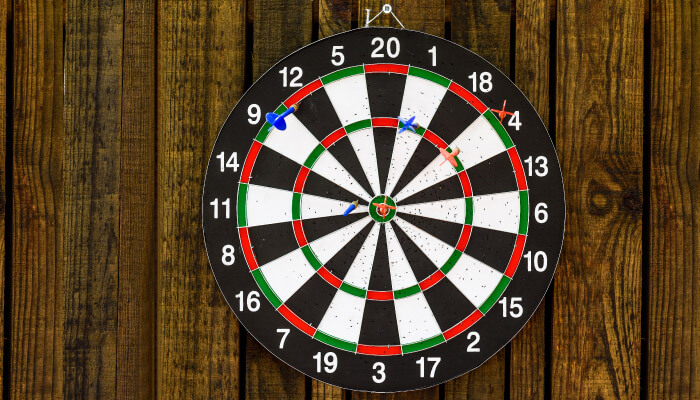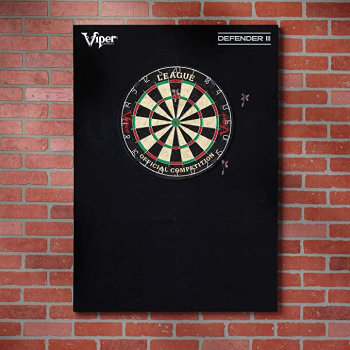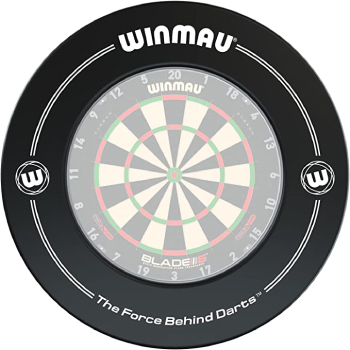Playing darts at home is fun unless you spot dents and holes in the wall. The damaged walls around your dart corner result from many misdirected darts and errant throws. Well, it happens even with the most skilled players. Though dart is a game of preciseness and accuracy, it’s normal to have bad days that cause unsightly damage to your walls.
So wall protection for dart boards is a concern for every dart enthusiast. We’ve got your back if you’re looking for solutions and protective measures to protect walls from darts!
This guide includes everything you need to know about protecting your wall from darts when you’re in a gaming mood. You’ll find effective options and suggestions that suit your budget and needs. We’ll also share some effective DIY solutions.
How to Protect Your Wall From Darts
Using a dartboard cabinet is the best way to protect your walls from darts. The bigger the dartboard, the more it covers the wall. If you miss the target, the dart will hit the cabinet keeping the walls safe. But mostly, when the darts hit the cabinet, they bounce off and hit the floor; thus, they can blunt the points or damage the floor.
A dartboard surround is another option to use as a dartboard wall protector. It’s a foam border, about 0’5 inch to 1 inch wide, around a dartboard. It is cut precisely according to the measurement to fit around a dartboard. It’s very easy to set up and remove after the game. This foam ring requires no tools or hardware for installation.
Another effective option to safeguard your walls is to use a dartboard backboard. This essential accessory protects your walls and adds a stylish touch to your dart gaming area. We’ve got you covered if you want to build your dartboard backboard.
Check out our comprehensive guide on building your dartboard backboard, which includes step-by-step instructions and tips to create a personalized and functional backboard that suits your budget and needs.
Using Dartboard Cabinet
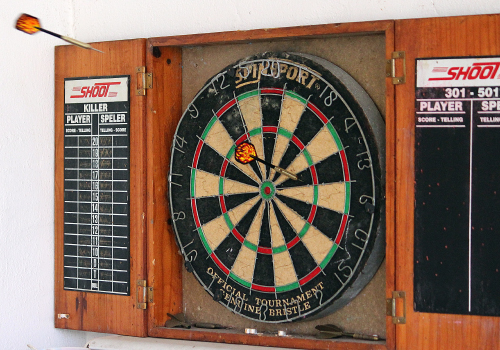
You already know how helpful it is to have dartboards with cabinets. You can store your darts and keep the corner organized. A cabinet also goes well with most home decor and creates a professional ambiance. Also, it safeguards the dartboard when you’re not playing games.
But what a dartboard cabinet does the best is to protect the wall behind from missed-hit darts. They are best for mid-level players to professionals as they miss targets a little less.
Dartboard cabinets come in different prices, sizes, and features. Comparing everything, you must choose the best dartboard cabinet to protect the wall from darts.
Open spaces will always be around the cabinet, no matter what size you buy. It won’t provide full protection for your walls. So it may not be your best option if you are a new player or learning darts. If you are an amateur, then our next method is for you.
Using Dartboard Surround
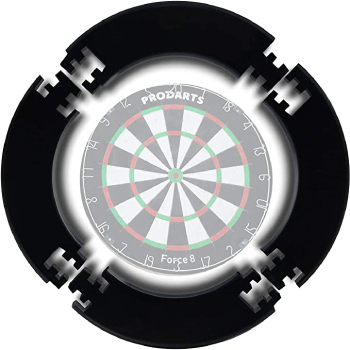
The dartboard surround helps the most when you’re throwing doubles. Doubles are placed on the edge of a dartboard; if the dart misses or slips, there is a risk of hitting the wall near the edge. But with a good quality dart board surround, the wall is protected as the dart will either hit the foam and fall off or get stuck in the foam ring.
However, the dartboard surround doesn’t offer broad protection. They aren’t too wide, so if you’re an expert but want minimal protection, you can go for a dartboard surround. Here are a few dartboards surrounds that you can buy:
5 DIY Methods to Protect Your Wall from Darts
DIY options may not always give the best results, but they will surely leave a touch of your style sense in your dart corner. The cost of the method depends on what materials you are using and how you arrange those. You may save some bucks by utilizing the things around the house.
However, you must consider three things before making any DIY dart protectors.
- Thickness: The material you will choose must be thick enough to protect the wall. Experts suggest using backboards at least 0.5 to 1 inch thick so the dart doesn’t travel through the protector.
- Softness: The material has to be soft to hold the miss-thrown dart. If it’s a hard surface, the dart will bounce off and hit other items around the dartboard.
- Weight: The material should be lightweight for carrying and installing it.
What to put behind a dart board to protect the wall
Here are 5 things that can be used in DIY methods for wall protection for dart boards:
Corks: Corks from your old drinks bottle can be customized as wall protectors.
You can arrange the corks in different patterns to match your style. They are thick and can hold darts when thrown.
Ropes: You can make a rope backboard by wrapping a few meters of rope in a round shape. You can use glue to attach the ropes or bind them with thin wires. This rope backboard is thick enough to prevent darts from hitting the wall. Since ropes are soft, the darts will stick to the rope wall protector. For an aesthetic look, pair a brown-toned rope protector with a wooden dartboard or paint the rope to match your decor.
Cardboard: Cardboards are common in almost every house. You can use layers of cardboard as backboards to place over the wall. It’s one of the cheapest DIY for protecting your walls.
Wooden door: Old wooden or cabinet doors are another option to protect the walls from sharp darts. It will prevent darts from hitting the walls and catch the sharp points when they land on it. You can use an old wooden door or plywood sheet for this DIY.
Towel: If you play darts occasionally and have nothing planned as a protector, you can use towels behind the dartboard. Thick towels folded and hung behind the dartboard will save your walls from the dart.
Towels as wall protectors won’t cost you a penny, as most of us have these at home. Also, towels are quite helpful if kids throw darts low. Though it’s not a quick solution for people who play darts at home seasonally, it’s a good way to protect the wall for a while.
You will not find all DIY solutions effective if you are a regular or professional player. Because most of the DIYs aren’t durable.
What Not to Place Behind a Dartboard:
- Avoid using hard materials such as metal or steel boards, tiles, or hardwood as a wall protector or backboard.
- Hard surfaces can blunt the tips of your darts and cause damage.
- Hard materials can be slippery, causing darts to bounce off and potentially hit the floor or other objects.
- Do not use anything that can hold moisture, as it can gradually damage the dartboard.
- Hanging the dartboard on a garden fence when playing outdoors is not recommended, as it can damage your darts.
Conclusion
A stray and miss-thrown dart can do much damage to your wall. So when playing darts, it’s important to protect the wall by using a wall protector for dartboards or backboards. Thus, your wall remains safe, and you can fearlessly hit the double or treble!
By following these guidelines, you can safeguard your walls and preserve the longevity of your dartboard. Investing in proper dartboard accessories and being mindful of what goes behind the board are crucial steps in maintaining a durable and well-protected setup.
This article covered essential methods to protect your walls from dart damage, including dartboard cabinets, dartboard surroundings, and selecting appropriate materials behind the dartboard. You can maintain a safe and long-lasting dart-playing environment by implementing these strategies.
To help others benefit from this information, consider sharing this article with your friends who enjoy playing darts.
Additionally, engage with the content by leaving comments or sharing your tips and experiences. Let’s create a community that promotes the joy of dart-playing while keeping our walls intact. Together, we can enhance our dart games and protect our surroundings.
